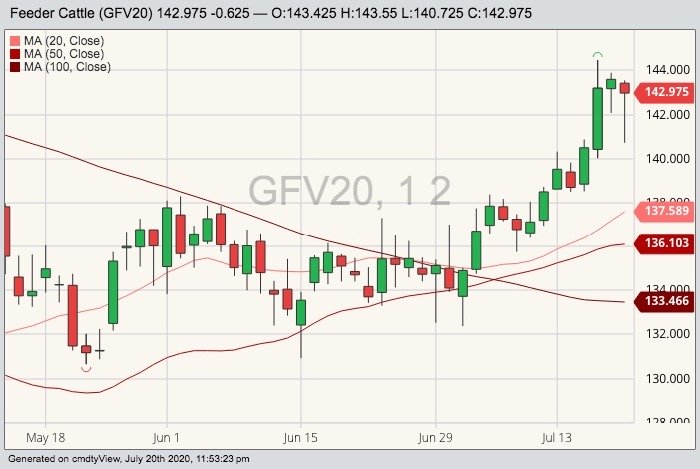The western Canadian feeder market was hard to define last week due to the small volumes. Small groups under 10 head were quite common and in many cases, one to three head were running through the ring. Discounts were quite severe on these stragglers; however, quality feeder cattle traded at similar levels to last week.
Pasture conditions are favourable across the Prairies and every farmer who has some grass available bought a few calves this spring. The abundant grass and forage conditions will likely delay marketings later in fall. Feedlot pen conditions are quite poor due to the excessive moisture and barley silage season is right around the corner. Buyers are not anxious to bring in fresh cattle at this time.
Read Also

U.S. grains: Wheat futures rise on supply snags in top-exporter Russia
U.S. wheat futures closed higher on Thursday on concerns over the limited availability of supplies for export in Russia, analysts said.
All eyes were on the feeder cattle futures this week as the October contract traded at the highest levels since early March. More importantly, the CME composite price, which is the official cash settlement price for the CME feeder cattle futures at contract final settlement has rallied US$10 over the past couple weeks. Strength in the February and April 2021 live cattle futures was also supportive. The feeder complex appears to shrugging off rising COVID cases in the U.S. and there is a high probability a vaccine will be available in late 2020 or early 2021.
In east-central Alberta, a group of four mixed steers averaging 820 lbs. were quoted at $186 and one 910-lb. steer sold for $165; one heifer weighing 845 lbs. was valued at $159. South of Edmonton, four red and white faced steers weighing 720 lbs. sold for $194 and four black heifers averaging 715 lbs. were valued at $174.
One Charolais steer weighing 650 lbs. sold for $207 in central Alberta and two mixed steers averaging 675 lbs. reportedly dropped the gavel at $212. One red heifer weighing 635 lbs. sold for $187. In southern Alberta, five mixed steers weighing 575 lbs. were valued at $226 landed in the feedlot and two Angus-based heifers weighing just over 500 lvs. were quoted at $177 in the same region. Market reports were hard to come by this week.
The barley market remains firm late in the crop year. China imposed tariffs on Australian barley back in May, which has caused Canadian exports to increase. At the same time, we’re seeing U.S. corn trade into southern Alberta at a discount to barley. This feed grain complex has uncertainty heading into new-crop positions. Saskatchewan barley prices are $4 per bushel for new crop. This may temper the upside in the feeder market longer term.
— Jerry Klassen manages the Canadian office of Swiss-based grain trader GAP SA Grains and Produits Ltd. and is president and founder of Resilient Capital, specializing in proprietary commodity futures trading and market analysis. Jerry consults with feedlots on risk management and writes a weekly cattle market commentary. He can be reached at 204-504-8339 or via his website at ResilCapital.com.
















